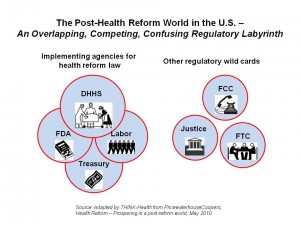 Good luck to stakeholders in navigating the health-regulatory labyrinth once health reform is implementing in the U.S. A report from PricewaterhouseCoopers (PwC) predicts, “A number of existing regulators will also have expanded roles as a result of the legislation.” These will be in addition to the new regulators identified by the law, which include but won’t be limited to:
Good luck to stakeholders in navigating the health-regulatory labyrinth once health reform is implementing in the U.S. A report from PricewaterhouseCoopers (PwC) predicts, “A number of existing regulators will also have expanded roles as a result of the legislation.” These will be in addition to the new regulators identified by the law, which include but won’t be limited to:
- CMS Innovation Center
- Independent Payment Advisory Board
- Health Insurance Reform Implementation Fund
- Patient-Centered Outcomes Research Institute
- National Prevention, Health Promotion and Public Health Council
- Task Forces on Preventive Services and Community Preventive Services
- Community-based Collaborative Care Network Program
- Community Living Assistance Services and Supports (CLASS) program
- Federal Coordinated Health Care Office (in CMS)
- Workforce Advisory Committee.
These new regulators will impact different stakeholders in various ways, from payers and providers to pharma and life science companies, employers, and of course, individual health citizens.
PwC’s report, Health Reform: Prospering in a post-reform world, lays out the way the world will look once reforms kick in. Their three-part story is: “new coverage, new funding, new regulators.”
Health Populi’s Hot Points: The complexity that PwC paints requires a new-new mindset for organizations involved in any aspect of health and health care. Bundled payments will concentrate the mind of payers, providers, suppliers to the industry (listen up, bio/life science and medical device companies). You’re now going to be partners-in-payment. Not competitors — partners. The new payment paradigm works for the patient’s overall outcome. Value and quality are paramount. Wastefulness, duplication, and opaque business practices will not play in this game.
The value story will play out for payers in that they’ll need to differentiate not only on price, but on what’s under the plans’ hood: offerings, quality, and sublime customer service — á la Netflix, Amazon, and Nordstrom — will win out. And again, transparency is the name of this game, in terms of pricing and quality. Arm the customer – whether aggregating payer (employer or government agency) or individual consumer — with useful information in the format and via the channels they want it.
As for health citizens, it will take more than a few minutes to understand the way this new world will work — particularly for newly covered health citizens. This time of the year is benefits information season for employers who offer health benefits. You think you’re confused now with the acronyms, co-payment tiers, and provider networks. This is a system you know. Kind of. While President Obama promised Americans they wouldn’t have to change their health plans in the post-reform world, he didn’t promise that you wouldn’t need more education on how the post-reform world would work.
And one sure forecast: health lawyers will be very busy…




 Thank you, Jared Johnson, for including me on the list of the
Thank you, Jared Johnson, for including me on the list of the  I am so grateful to Tom Lawry for asking me to pen the foreword for his book, Health Care Nation,
I am so grateful to Tom Lawry for asking me to pen the foreword for his book, Health Care Nation,  Thanks to Feedspot for naming this blog, Health Populi, as a
Thanks to Feedspot for naming this blog, Health Populi, as a